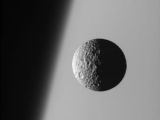Saturn is the planet with the largest number of moons in the solar system. These moons come in all shapes, structures and sizes. Here are some of the most amazing pictures taken by the Cassini probe to Saturn.
Saturn's little moon Atlas orbits Saturn between the outer edge of the A ring and the fascinating, twisted F ring. This image just barely resolves the disk of Atlas, and also shows some of the knotted structure for which the F ring is known. Atlas is 32 kilometers (20 miles) across.
The bright outer edge of the A ring is overexposed here, but farther down the image several bright ring features can be seen.
The image was taken in visible light with the Cassini spacecraft narrow-angle camera on April 25, 2005, at a distance of approximately 2.4 million kilometers (1.5 million miles) from Atlas and at a Sun-Atlas-spacecraft, or phase, angle of 60 degrees. Resolution in the original image was 14 kilometers (9 miles) per pixel.
Saturn's moon Pan occupies the Encke Gap at the center of this image, which also displays some of the A ring's intricate wave structure. Pan is 26 kilometers (16 miles) across.
The two most prominent bright banded features seen on the left side of the image are spiral density waves, which propagate outward through Saturn's rings. The bright crests represent areas with higher ring particle densities.
The image was taken in visible green light with the Cassini spacecraft narrow-angle camera on Aug. 1, 2005, at a distance of approximately 794,000 kilometers (493,000 miles) from Pan. The image scale is 5 kilometers (3 miles) per pixel.
This amazing perspective view captures battered Mimas against the hazy limb of Saturn. It is obvious in such close-up images that Mimas (397 kilometers, or 247 miles across) has been badly scarred by impacts over the eons. Its 130 kilometer- (80 mile-) wide crater, Herschel, lies in the darkness at right. North on Mimas is up and rotated 19 degrees to the right.
The image was taken with the Cassini spacecraft narrow-angle camera on March 21, 2006 using a filter sensitive to wavelengths of ultraviolet light centered at 338 nanometers. The image was acquired at a distance of approximately 191,000 kilometers (119,000 miles) from Mimas and at a Sun-Mimas-spacecraft, or phase, angle of 91 degrees. Image scale is 1 kilometer (3,730 feet) per pixel.
Cassini looks down upon Rhea, whose cratered surface was already ancient before any complex life developed on Earth. The terrain seen here has probably changed little in the past billion years.
This view shows terrain on the Saturn-facing hemisphere of Rhea (1,528 kilometers, or 949 miles across). North is up. The image was taken in visible light with the Cassini spacecraft narrow-angle camera on March 21, 2006 at a distance of approximately 94,000 kilometers (59,000 miles) from Rhea and at a Sun-Rhea-spacecraft, or phase, angle of 109 degrees. Image scale is 558 meters (1,832 feet) per pixel.
Bright, wispy markings stretch across a region of darker terrain on Saturn's moon Rhea. In this extreme false-color view, the roughly north-south fractures occur within strips of material (which appear greenish here) that are a different color from the surrounding cratered landscape. To create the false-color view, ultraviolet, green and infrared images were combined into a single black and white picture that isolates and maps regional color differences. Most of the large-scale variations in brightness across the surface are removed by this process. This "color map" was then superimposed over a clear-filter image. The origin of the color differences is not yet understood, but it may be caused by subtle differences in the surface composition or grain sizes making up the icy soil. Wispy markings were seen on the trailing hemispheres of both Rhea and Dione in images taken by NASA's Voyager spacecraft, and were hypothesized by some researchers to be the result of material extruded onto the surface by ice volcanism. Cassini's earlier revelation of the braided fractures on Dione led to speculation that Rhea's wisps might also be created by fractures. This view shows terrain on the trailing hemisphere of Rhea (1,528 kilometers, or 949 miles across). North is up. The image was taken using the Cassini spacecraft narrow-angle camera on Jan. 17, 2006, at a distance of approximately 245,000 kilometers (152,000 miles) from Rhea and at a Sun-Rhea-spacecraft, or phase, angle of 30 degrees. Image scale is 1 kilometer (4,771 feet) per pixel.
This stunning false-color view of Saturn's moon Hyperion reveals crisp details across the strange, tumbling moon's surface. Differences in color could represent differences in the composition of surface materials. The view was obtained during Cassini's close flyby on Sept. 26, 2005.
Hyperion has a notably reddish tint when viewed in natural color. The red color was toned down in this false-color view, and the other hues were enhanced, in order to make more subtle color variations across Hyperion's surface more apparent.
Images taken using infrared, green and ultraviolet spectral filters were combined to create this view. The images were taken with the Cassini spacecraft's narrow-angle camera at a distance of approximately 62,000 kilometers (38,500 miles) from Hyperion and at a Sun-Hyperion-spacecraft, or phase, angle of 52 degrees. The image scale is 362 meters (1,200 feet) per pixel.
Credit: NASA/JPL/Space Science Institute
Continue the exploration: What's Going On Around Saturn? (part 2)

 14 DAY TRIAL //
14 DAY TRIAL // 





